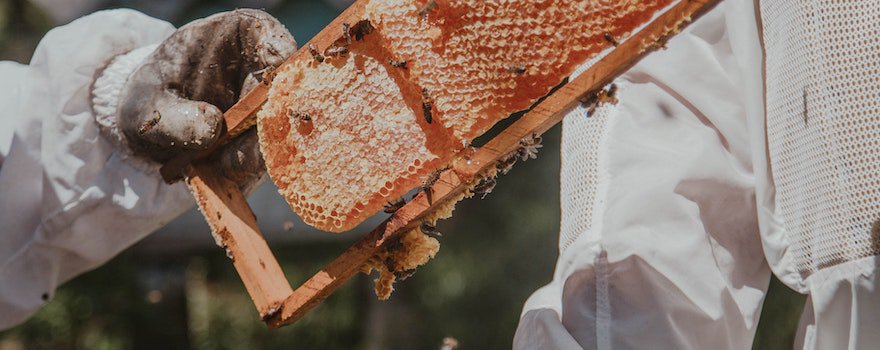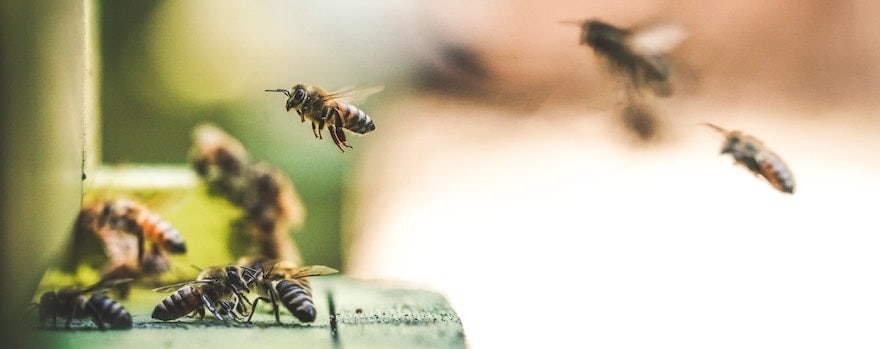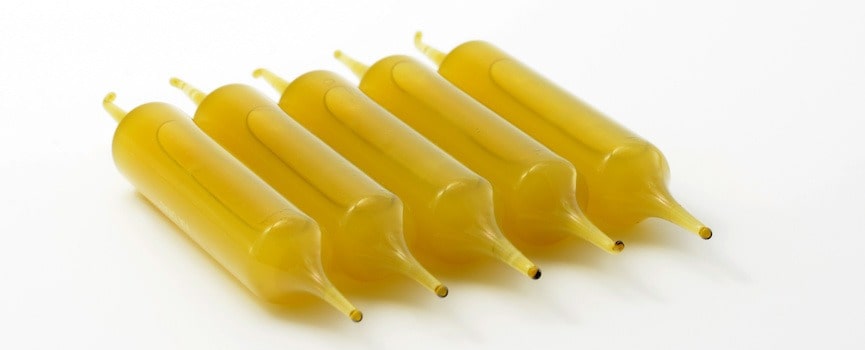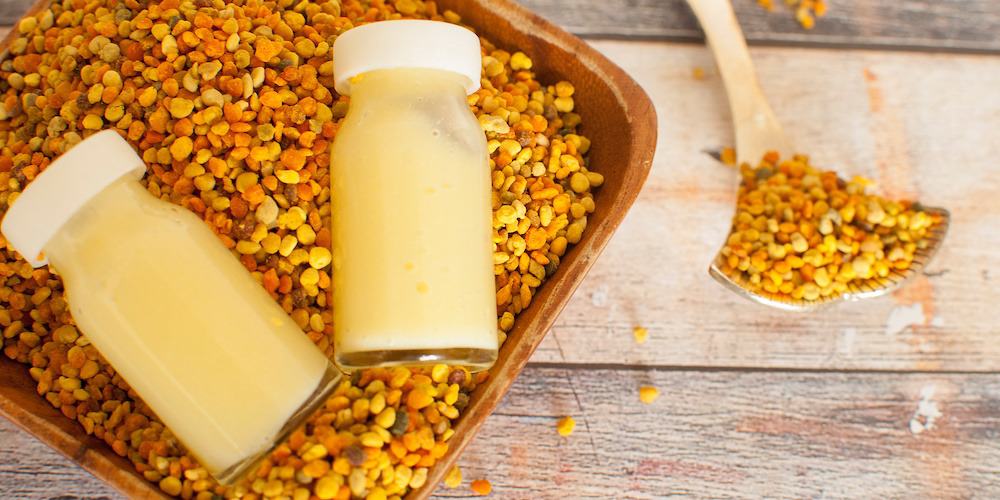BENEFITS OF ROYAL JELLY
✓ Strengthens the immune system
✓ Natural source of antioxidants, anti-aging
✓ Relieves menopause symptoms
✓ Anti-inflammatory
✓ Reduces blood pressure
What is royal jelly?
Royal jelly is a milky secretion produced by bees to feed the larvae of the colony and the queen. It comes more precisely from the hypopharyngeal and mandibular glands of the bees. If all the larvae benefit from it until they hatch, only the queen consumes it throughout her life.
It is a gelatinous substance of a yellowish to whitish color – it whitens on contact with air, especially when it is collected. That may not sound very appetizing put that way, but rest assured, it has a tart and very sweet flavor!

The queen of a colony can live 5 to 6 years, while worker bees live about 45 days. Royal jelly may be one of the causes of this the queen’s resilience and longevity. It is a particularly rare product, because a hive cannot naturally produce more than 300 g per year.
Thus, even though its use has been recorded for centuries, in ancient Egypt, as well as in traditional Chinese medicine, its consumption remained very limited and reserved for a few privileged people. It was used specifically to combat fatigue, strengthen the body and promote longevity. This is also the case in Russia and Eastern Europe, where it is moreover associated with adaptogenic substances.
Today, beekeepers have developed techniques aimed at increasing royal jelly production and its preservation, notably using a process of freeze-drying – or cold drying. Its consumption has therefore become more widespread, and it is now readily available in pharmacies, organic and health food stores.
From a nutritional standpoint, royal jelly is particularly rich. Composed of 60% water, the remaining 40% is made up of carbohydrates, proteins, lipids, minerals, vitamins, and amino acids.
This nutritional richness is thought to be behind its numerous medicinal properties, and above all its ability to strengthen our immune system. However, the scientific studies proving these claims are still scarce, and the majority of those corroborating its properties were carried out in vitro or in animals.
It is consumed as a dietary supplement, in ampoules, or fresh. It can also be used in cosmetics, applied to the skin.
Nutritional composition
- Protéines
- Acides aminés
- Glucides : fructose et glucose
- Lipides : acides gras saturés dont stéarique et palmitique
- Minéraux et oligo-éléments : calcium, magnésium, potassium, phosphore, fer, cuivre
- Vitamines : B1, B2, B3, B5, B6, B9 ou acide folique

Benefits
🛡 Strengthens the immune system
Royal jelly is known to strengthen the immune system and thus protect the body from viruses and bacteria.
What explains this particular property is the presence of certain fatty acids and proteins in royal jelly, notably MRJPs (Major Royal Jelly Proteins). These have antibacterial activity and support immune function.
So far, most studies are in vitro or in animals, but the results support a boost to the immune system.
This study conducted by several Italian universities and the University of Macau established the immunostimulatory and antimicrobial activities of various compounds in royal jelly.
🥝 Natural source of antioxidants, anti-aging
Royal jelly is also a natural source of antioxidants. Some amino acids, fatty acids, and phenolic components in its composition have a strong antioxidant activity. They help combat free radicals and cellular aging.
It can, in particular, be used as an anti-aging skin treatment, as it can increase collagen production. In addition, it protects the skin from UV damage, one of its main causes of aging.
This study from Kyung Hee University in Korea, conducted on rats, showed that royal jelly helped increase collagen production.
🌺 Relieves menopause symptoms
Royal jelly can be a natural and effective ally in the fight against menopause-related disorders.
Among the symptoms observed, hot flashes, weight gain, migraines, anxiety, and back pain are the most common. Two-thirds of menopausal women are affected by these disorders.
Compounds in royal jelly have an estrogenic activity, and may help relieve menopausal symptoms. They also promote a healthy hormonal balance in women. To relieve these disorders, a course of maca is also recommended.
This study from Kindai University in Osaka, Japan, conducted on 42 postmenopausal women, showed that daily consumption of 800 mg of royal jelly for 12 weeks significantly reduced back pain and anxiety.
🌵 Anti-inflammatory
Royal jelly has a anti-inflammatory activity that helps fight various types of inflammation. Three fatty acids in particular are believed to be responsible for this property.
This study conducted in vitro by various Chinese researchers demonstrated the anti-inflammatory capabilities of three fatty acids that make up royal jelly.
🍳 Cholesterol-lowering
Another property of royal jelly is to lower the level of bad cholesterol in the blood. As a result, it helps reduce the risk of cardiovascular events.
Specific proteins are believed to be involved. Studies have been conducted both on animals and in humans, but the results need to be confirmed by further studies.
This study from Chung Shan Medical University in Taiwan, conducted on 40 people, showed that those who consumed 3 g of royal jelly per day for a month saw their levels of bad cholesterol decrease.
☁️ Reduces blood pressure
Royal jelly helps reduce blood pressure, thereby protecting the heart and promoting good circulation.
It acts directly on the walls of veins and arteries by making them more flexible. It thus reduces blood pressure and improves circulation. Some proteins that make it up are believed to be responsible for this property.
This study from Fuzhou University in China showed that a dietary supplement composed of various bee products helped reduce blood pressure in rats, although the exact role of royal jelly could not be determined.

How to consume royal jelly?
Prefer organic, French royal jelly
It is recommended to prefer organic, French-origin royal jelly to ensure better quality, traceability, and absence of pesticides. Its composition and nutritional benefits vary depending on the environment and flora around the hives.
Today, products originating from Asia flood the market. Imported cheaply, their production conditions and health benefits are being called into question.
Beyond health and environmental aspects, buying a French product helps support a quality industry that faces many difficulties. Overwhelming competition from imports, reduced biodiversity, new predators, pesticides…
French beekeepers have come together within the Royal Jelly Producers Group, which, notably through the creation of a label, aims for excellence in the production and preservation of the product.

Fresh
Consuming fresh royal jelly is the best way to benefit from its nutritional properties. A product that is neither processed nor frozen is a sign of quality, and the fatty acids and proteins responsible for its benefits are better preserved.
You can obtain it directly from a beekeeper, or in an organic store. It should be kept in the refrigerator.
Freeze-dried
Lyophilized royal jelly is obtained by dehydrating the fresh product. It is mainly available in the form of capsules and tablets, and is suitable for people who do not like its taste.
In vials

This is the form you’ll most easily find on the market, in pharmacies, parapharmacies, organic stores… Ampoules are ideal for starting a course, as the dosage is exact. Be sure to choose fresh royal jelly ampoules from the French supply chain. Check the ingredients carefully, as manufacturers tend to add other compounds, including sugar.
Dosage
⚖️It is recommended to consume 300 mg to 1.2 g of fresh royal jelly per day, and up to 400 mg of lyophilized royal jelly.
⏳In general, it is recommended to take three-month courses during seasonal changes when the body may be weakened.
🍯Fresh : one teaspoon per day in the morning
🥃In ampoule form : one ampoule diluted in a glass of water in the morning
💊In tablet form lyophilized : according to the tablet dosage
Contraindications and side effects
It is contraindicated for people with allergies to other hive products, such as honey, pollen, or wax. Allergens may also be present in products containing pesticides and can trigger asthma.
It is also not recommended for pregnant or breastfeeding women. Seek medical advice regarding children.
History, culture, and market
Create orphan hives
All hives produce royal jelly, but in quantities far too small for human consumption. Nurse bees secrete only the volume necessary for rearing the brood and do not store it.
To increase the production of a hive, beekeepers have developed new techniques. They notably carry out “orphaning”, which involves removing the queen from a colony so that the nurse bees begin to produce more royal jelly.
A four-step production process
- Le greffage : hors de la ruche, on place des larves âgées de 12 à 36h dans de fausses alvéoles royales sur un cadre
- L’introduction : on place ce cadre dans la ruche orphelinée. Les abeilles nourrices vont améliorer les alvéoles et donner abondamment de la gelée royale aux larves.
- La récolte : après trois jours, lorsque les cellules ont atteint leur maximum d’abondance, on retire le cadre.
- L’extraction : on prélève la gelée royale dans chaque cellule. Une ruche peut ainsi fournir jusqu’à 1000 g de gélée par an.
As for its price, the French-origin one costs about €2,300 per kg, while the imported one comes to an average of €300 per kg.



